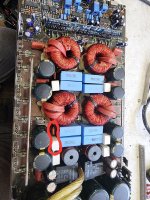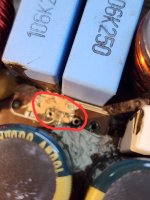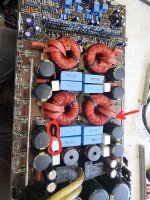Hi all
I am trying to fix the above mentioned amplifier. Outputs and power supply mosfets had blown. Changed the power supply fets. Also changed the bad shorted audio ic in output driver card. Amp powers up without outputs installed. But the two caps mentioned in the picture gets very hot and there is no low side drive. Amp trying to pull plenty current. I am sure is because of those two caps. I removed both and xhecked them and they are good. Anybody has any schematics or any idea about this issue. Thank you.
I am trying to fix the above mentioned amplifier. Outputs and power supply mosfets had blown. Changed the power supply fets. Also changed the bad shorted audio ic in output driver card. Amp powers up without outputs installed. But the two caps mentioned in the picture gets very hot and there is no low side drive. Amp trying to pull plenty current. I am sure is because of those two caps. I removed both and xhecked them and they are good. Anybody has any schematics or any idea about this issue. Thank you.
Attachments
Isn't one of the two highlighted components a resistor?
Is there any DC voltage across that resistor?
Is there any DC voltage across that resistor?
Oh sorry one is resistor and one capacitor. It was typing mistake. I removed the cap and resistor. Now amp coming with good low side oscillations on all the four set outs. Do you want me install back the resistor and cap and measure dc across the resistor. Or measure dc without resistor.
I installed the two components and using current limit resistor the voltage across highlighted resistor is about 9v
Is that capacitor shorted?
What's the DC voltage on the positive and negative speaker terminals (black on primary ground)?
What's the DC voltage on the positive and negative speaker terminals (black on primary ground)?
Here it is little different. One side of resistor is connected to negative speaker terminal and another side is connected to capacitor and capacitor another side is connected to coil. The side of Resistor that is connected capacitor is having -9v.
If you remove only the resistor, does the capacitor get hot?
If you remove only the capacitor, does the resistor get hot?
How much current is the amp drawing?
If you remove only the capacitor, does the resistor get hot?
How much current is the amp drawing?
With capacitor alone there is no problem getting oscillations and pulling 1.6amps. With resistor alone the resistor getting hot and pulling more than 2amps as I am using current limiter it stays at 2amp but limiting resistor gets hot.
There is black glue that dried on top of board when I cleaned it I found the place around capacitor end that connects to resistor is burned and carbon around it. Picture attached. No matter how much I clean it is still conducting. I wonder if to cut the trace and connect it from behind.
Attachments
You can hard-wire it without connecting to the traces.
Is this the same fixative that is normally beige and turns dark/black as it ages or is it a fixative that's rubbery and always black?
Is this the same fixative that is normally beige and turns dark/black as it ages or is it a fixative that's rubbery and always black?
Rubbery always black. It became very hard. Also the capacitor it had before had broken leg may be it was always getting hot and finally when too much board burn and became carbon it spoiled whole amp.
You'll have to remove ALL of the carbonized fiberglass if you intend to use the same hole to wire it to other components. You have to cut back to where the fiberglass is perfectly white.
Thank you for everything Sir. I cut the track and hard wired it from back. Everything seems to be good. But I have one doubt on one of the coil the colour of wire became dark. I dont know if that will give any problem. But the outputs those are connected to that coil were good. Please check the image.
Attachments
That's likely due to a short between the windings. You may be able to unwrap it and insulate it. When you power the amp back up (completely reassembled), let it idle (confirming that it has rail-rail oscillation on the output transistors) and monitor that part of the coil to confirm that it's not heating more than the rest of the windings.
- Home
- General Interest
- Car Audio
- VFL 500.1


